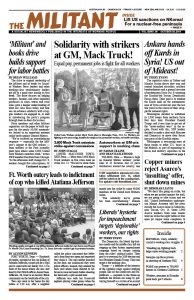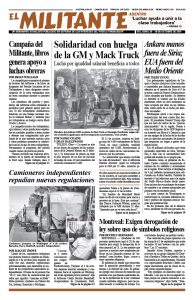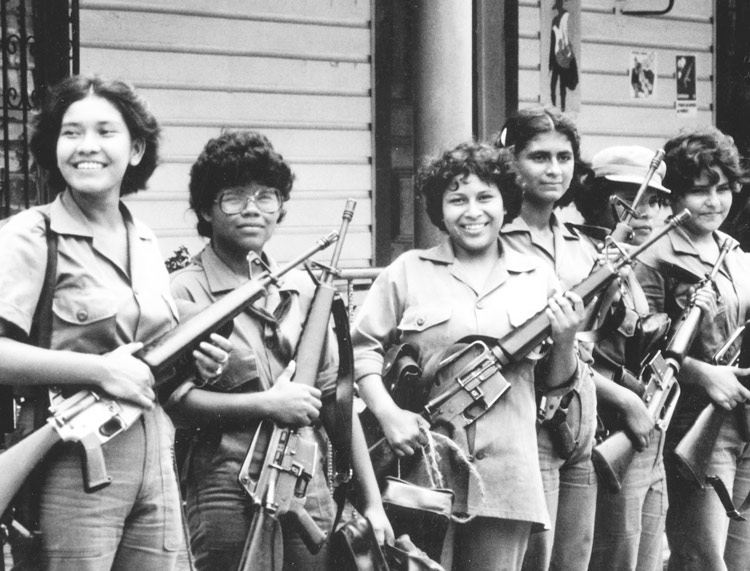Nicaragua: The Sandinista People’s Revolution, with speeches and interviews by leaders of the Sandinista National Liberation Front (FSLN), is one of Pathfinder’s Books of the Month for October. The excerpt is from a 1982 speech, “Women and the Nicaraguan Revolution,” by Tomás Borge. Under the FSLN-led workers and farmers government established in 1979, women made gains. The Nicaraguan Revolution inspired popular struggles across Central America and reinforced the Cuban Revolution. However, by the late 1980s, the FSLN leadership had abandoned its working-class course, and efforts to look to the example of the socialist revolution in Cuba. This led to the erosion of the revolutionary foundations of the FSLN, which degenerated into a radical bourgeois electoral party. It lost power in a February 1990 election. Copyright ©1985 by Pathfinder Press. Reprinted by permission.
BY TOMÁS BORGE
The woman question is nothing more than an aspect of social reality in its totality. The definitive answer to the liberation of women can emerge only with the total resolution of the class contradictions, of the social diseases that originate in a society like ours — politically liberated but with the rope of economic dependence still around our neck. …
Before the revolutionary triumph, the incorporation of women in productive work was minimal. The great majority of women were condemned to slavery in the home. When women could sell their labor power, in addition to fulfilling their obligations on the job, they had to fulfill their duties in the home to assure the upbringing of their children. All of this in a regime of political oppression and misery imposed by a dependent capitalist society. And subjected, on the other hand, to exploitation by man — the males of the species — who placed on the woman’s shoulders the fundamental weight of household chores, thereby endlessly prolonging her working day.
Did this end with the triumph of the Sandinista people’s revolution, we ask ourselves?
The triumph of the Sandinista people’s revolution eliminated the terror and opened the way for the process of national liberation, initiating at the same time economic and social transformations that represented a qualitative advance in the conquest of freedom and development.
It can’t be said, therefore, that the situation of women in Nicaragua has in no way changed.
The entire society seized its future and women gained the right, taking into account their varied and even spectacular participation in the revolutionary struggle, to participate in an active manner in the process of national transformation.
Nevertheless, all of us have to honestly admit that we haven’t confronted the struggle for women’s liberation with the same courage and decisiveness. …
Independently of the fact that women often receive the help of men, the truth is that the customs and level of development of our society impose this superexploitation on women. And it is in this sense that women are not only exploited — they’re superexploited. They are exploited in their workplaces, if they work. They are exploited by lower wages and exploited in the home. That is, they are triply exploited.
What can be done to eliminate this dramatic plight of women?
There is no other alternative except to change the basic economic structure of society. There is no alternative but to develop an economy that guarantees the satisfaction of the fundamental needs of our people. There is no alternative but to create a productive apparatus whose rationale is not individual profit, but rather satisfaction of the demands of the entire society, the demands of the workers — whose rationale is to reaffirm and emphasize the potential of man and woman to live together socially as human beings.
This process of change, compan?eras, is complicated, difficult, and will take place over time. But are we going to wait until economic development and social transformation have reached their culmination before we begin to think out the woman question? This would certainly be an inconsistency.
But how can we begin to conceive of women’s liberation right now with all the existing limitations?
We took, as we said, the first step, which was national liberation. Now we must take concrete steps to legally guarantee in daily practice full equality between the sexes. [Applause]
Men and women had the right and the duty to fight — to participate in the revolutionary struggle. Women played an outstanding role in the guerrilla struggle, in the clandestine struggle, in self-denial, in sacrifice, and in dedication. …
A concrete answer to these questions will be possible only to the extent that the individual tasks of women are socialized. It is society that has to provide the necessary day-care centers, laundries, people’s restaurants, and other services that will, in effect, free women from household work. This is not easy.
So far, the revolution has only been able to build twenty child-care centers — obviously an insufficient number. The problem is that the cost of construction, equipment, and maintenance is very high. With all the economic difficulties that are holding our country back, it’s impossible for us to move forward to the massive creation of these centers. And yet we must do it — not only to enable women to dedicate themselves to productive, social, and cultural tasks, but also to assure that the overall education of our children is as rich as possible.
How can we do it? How can we overcome this contradiction between the possible and the necessary?
We must look for audacious answers, I believe — answers based not so much on purely budgetary considerations but on the initiative, organization, and strength of the masses. Here AMNLAE [Association of Nicaraguan Women] should be the leading force and catalyst of these initiatives, fundamentally in coordination with the CDSs [Sandinista Defense Committees]. [Applause and slogans]
This is possible in a revolutionary society. There is no task that wouldn’t be possible for the revolutionary masses and there is no task that wouldn’t be possible for Nicaraguan women. [Applause]


